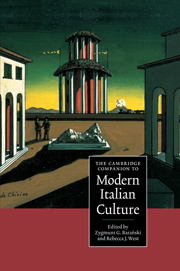Book contents
- Frontmatter
- Introducing modern Italian culture
- 1 The notion of Italy
- 2 Social and political cultures in Italy from 1860 to the present day
- 3 Questions of language
- 4 Intellectuals, culture and power in modern Italy
- 5 Catholicism
- 6 Socialism, Communism and other ‘isms’
- 7 Other voices: contesting the status quo
- 8 Narratives of self and society
- 9 Searching for new languages: modern Italian poetry
- 10 Drama: realism, identity and reality on stage
- 11 Italian cinema
- 12 Art in modern Italy: from the Macchiaioli to the Transavanguardia
- 13 A modern identity for a new nation: design in Italy since 1860
- 14 Fashion: narration and nation
- 15 The media
- 16 Since Verdi: Italian serious music 1860-1995
- 17 Folk music and popular song from the nineteenth century to the 1990s
- 18 Epilogue: Italian culture or multiculture in the new millennium?
- Index
- Series List
17 - Folk music and popular song from the nineteenth century to the 1990s
Published online by Cambridge University Press: 28 May 2006
- Frontmatter
- Introducing modern Italian culture
- 1 The notion of Italy
- 2 Social and political cultures in Italy from 1860 to the present day
- 3 Questions of language
- 4 Intellectuals, culture and power in modern Italy
- 5 Catholicism
- 6 Socialism, Communism and other ‘isms’
- 7 Other voices: contesting the status quo
- 8 Narratives of self and society
- 9 Searching for new languages: modern Italian poetry
- 10 Drama: realism, identity and reality on stage
- 11 Italian cinema
- 12 Art in modern Italy: from the Macchiaioli to the Transavanguardia
- 13 A modern identity for a new nation: design in Italy since 1860
- 14 Fashion: narration and nation
- 15 The media
- 16 Since Verdi: Italian serious music 1860-1995
- 17 Folk music and popular song from the nineteenth century to the 1990s
- 18 Epilogue: Italian culture or multiculture in the new millennium?
- Index
- Series List
Summary
In 1954, when the ethnomusicologist Alan Lomax (1915- ) took a six-month trip to Italy together with Diego Carpitella to record original folk music, the country that he found was scarred by the Second World War and still dominated, in large areas of the southern countryside, by a rural and archaic culture. For the purpose of his research, however, Italy was an untouched paradise, as precious to an ethnomusicologist as Hungary had been to Bartó and Kodály.' ‘The tradition of Italian folk music is arguably one of the least spoiled, most vigorous, and varied of Western Europe’, he wrote. And yet Lomax realized that the situation was changing:
So far as the Italian amusement industry is concerned, the only worthwhile native song traditions are those of Naples and the Alps. The combined battery of radio, television, and the jukebox pours out a steady barrage of Neapolitan song, American jazz, and opera, day in and day out, as if some unseen musical administrators had resolved to wipe out the enemy, folk music, as quickly as possible.
It is true that, as Italy underwent a major transformation from rural economy to city-based industry, folk music reminded urban people of the oppressive peasant life that they were eager to leave behind. In his massive study of the origins of the tarantella as a medicine ritual, the anthropologist Ernesto De Martino (1908–65) could still experience the richness of southern lore in connection with music. But in the new soundscape provided by radios, the jukebox and public television (which was introduced in 1954), folk music was non-existent.
- Type
- Chapter
- Information
- The Cambridge Companion to Modern Italian Culture , pp. 325 - 336Publisher: Cambridge University PressPrint publication year: 2001
- 1
- Cited by

